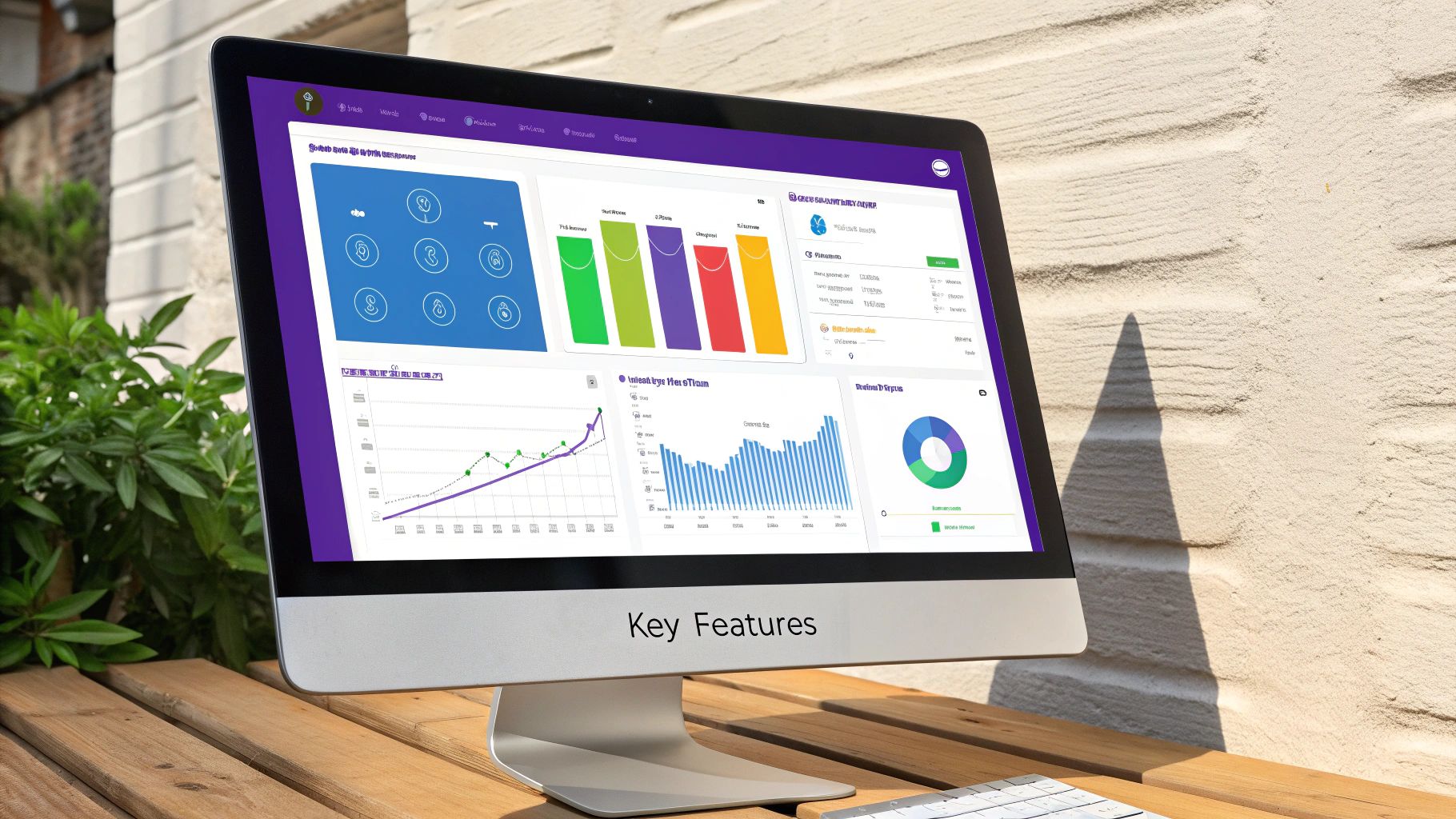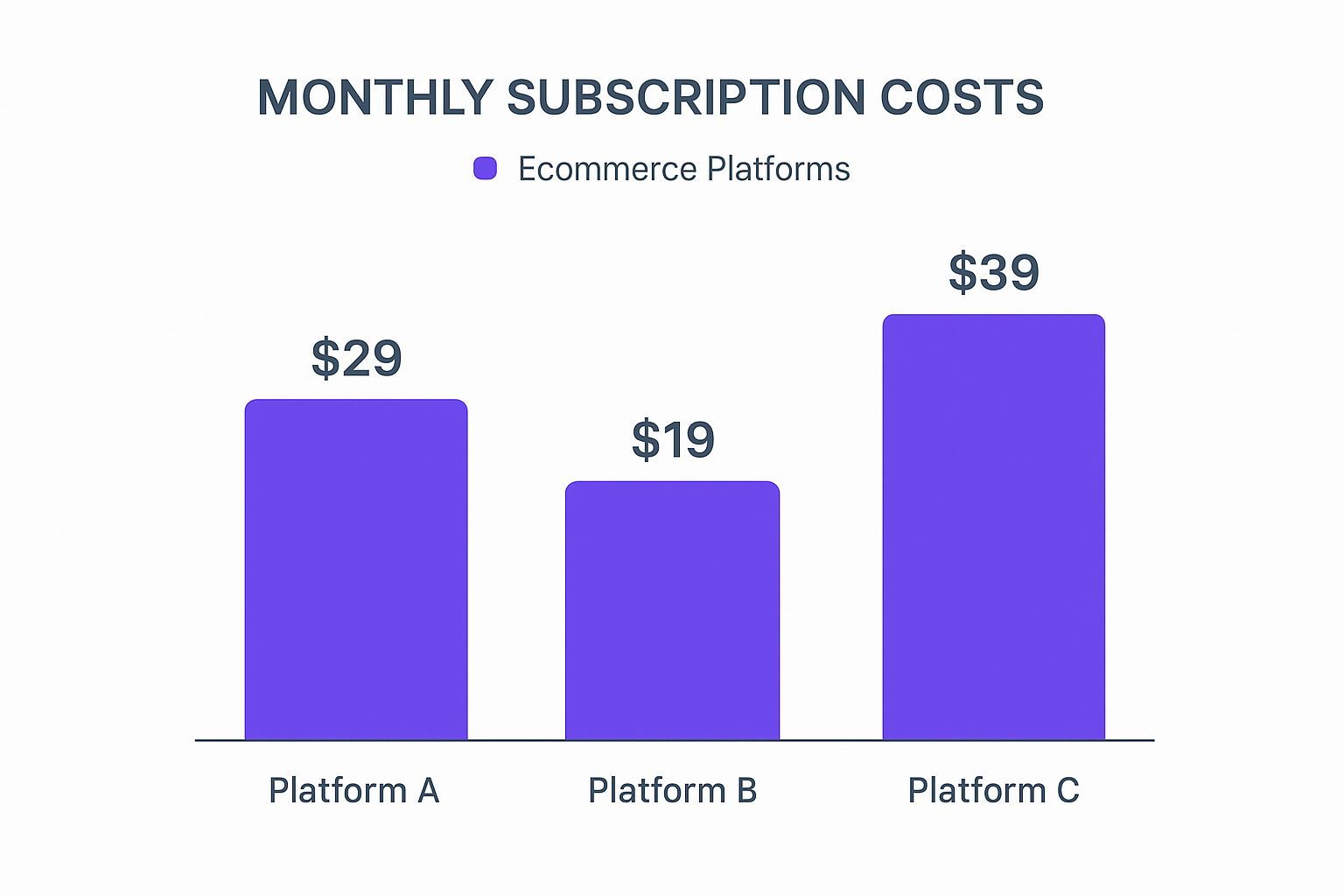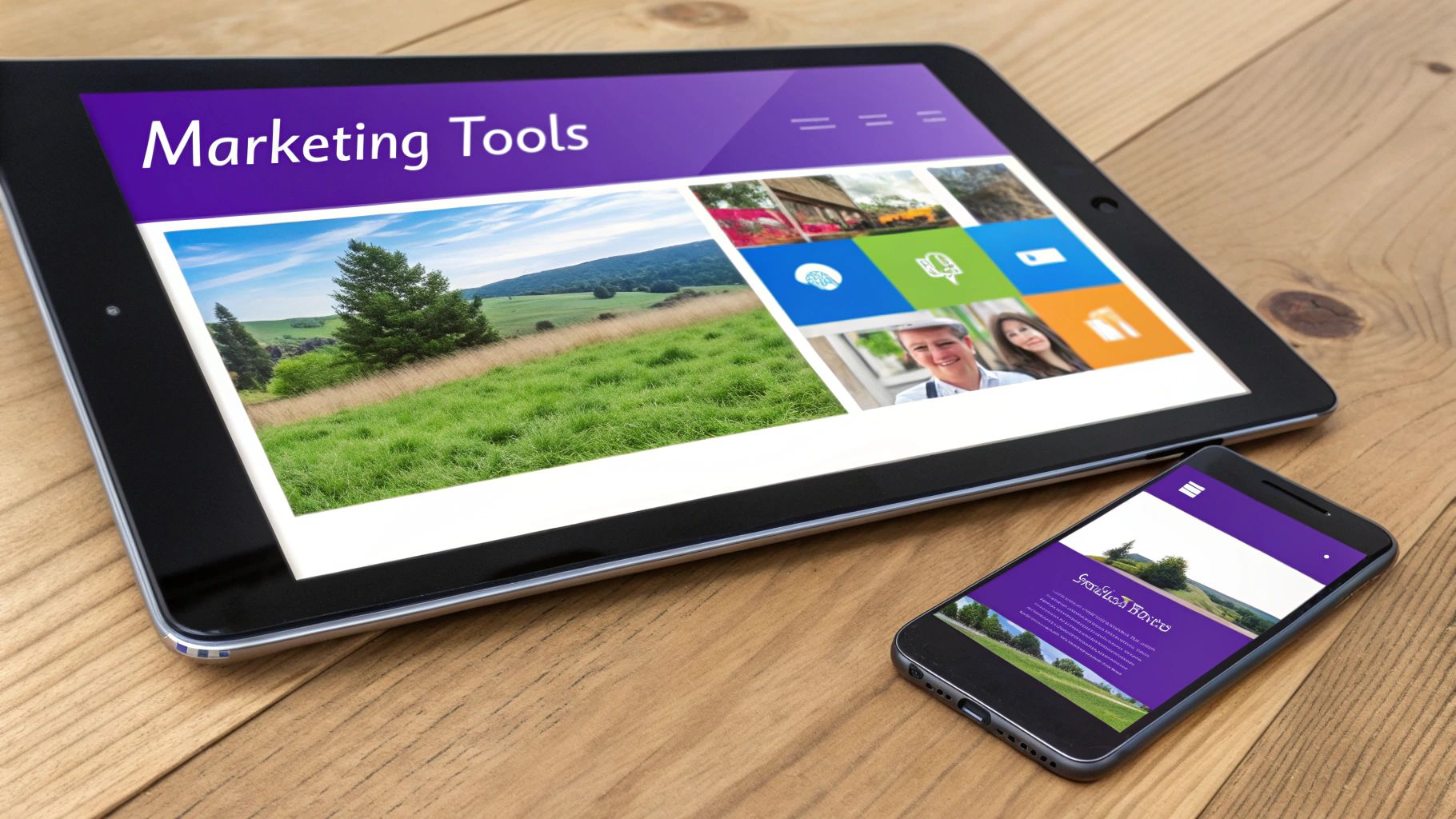Choosing an Ecommerce Platform for Small Business Success

Picking the right ecommerce platform for your small business is one of the biggest decisions you'll make. Seriously. This isn't just about building a website; it's about choosing the foundation for your sales, marketing, and customer relationships. It's the engine that will either power your growth or become a major headache down the road.
Why Your Platform Choice Is a Critical Business Decision

Think of your ecommerce platform as your digital storefront. But it’s more than just the four walls and a roof—it’s the prime real estate, the slick store layout, the security cameras, and your best salesperson all rolled into one. The platform you choose directly shapes how customers see your brand and how smoothly you can manage everything behind the scenes.
This one decision impacts several huge parts of your business:
- Customer Experience: We've all abandoned a cart because a website was slow or the checkout was a confusing mess. Your platform defines that entire journey, from the moment a customer lands on a product page to the final click to buy.
- Operational Efficiency: The way you track inventory, fulfill orders, and manage shipping all comes down to your platform’s built-in tools. The right one can save you from a mountain of manual work every single week.
- Marketing and SEO: The best platforms have tools designed to get you found on Google and connect with your audience on social media. Your ability to bring in new customers is tied directly to the marketing features your platform offers.
The online marketplace is packed. There are now around 30.7 million ecommerce sites worldwide, and the interesting part is that a whopping 70% of them are small businesses bringing in less than $1 million a year. That stat alone shows how crucial it is to pick a platform that gives you a fighting chance. You can discover more insights on the state of ecommerce for small businesses and see how these numbers affect your decision.
The real question isn't, "Which platform is the best?" It’s, "Which platform is the best for my specific business, my budget, and where I want to be in a few years?"
Answering that means looking past the shiny ads and really understanding the trade-offs between the big players like Shopify, WooCommerce, and BigCommerce. Each one was built for a different kind of entrepreneur, and this guide is here to help you figure out which one is your perfect match.
The Core Criteria for Comparing Ecommerce Platforms

Before we jump into a side-by-side breakdown, we need to get our priorities straight. Picking the best ecommerce platform for a small business isn’t about chasing the one with the flashiest features. It's about finding a partner that truly fits your business—your budget, your technical skills, and your vision for the future.
Let's lay out the benchmarks that really count. These are the things that will shape your daily work and ultimately determine how smoothly your business runs and grows.
Evaluating True Cost and Pricing Models
That initial price tag you see? It's just the tip of the iceberg. A "free" open-source platform like WooCommerce might not have a monthly subscription, but you'll be paying for web hosting, security certificates, and premium plugins to get the job done. In contrast, an all-in-one solution like Shopify bundles most of that into a clear monthly fee but might charge extra transaction fees if you don’t use its in-house payment gateway.
Think about the total cost of ownership. It’s more than just the subscription.
- Transaction Fees: Most platforms charge a small percentage on each sale, and that’s on top of what payment processors like Stripe or PayPal take.
- Essential Apps & Plugins: Do you need special apps for email marketing, customer reviews, or to offer subscriptions? These monthly costs can stack up fast.
- Theme Costs: A great-looking theme that helps you sell can be free, but premium designs often cost a few hundred dollars upfront.
Gauging Ease of Use
Honestly, how much time do you want to spend tinkering? Ease of use is all about how fast you can get your store launched and looking sharp without having to hire a developer. This is where platforms like Shopify and Squarespace really shine; their drag-and-drop builders are famous for being incredibly user-friendly.
On the flip side, a powerhouse like WooCommerce gives you incredible control but expects more from you. You’re in the driver's seat for updates, security, and hosting, which means you need to be a bit more tech-savvy or willing to learn.
Ease of use isn’t just about the setup. It’s about how simple it is to add a new product, run a flash sale, or pull a sales report on a busy Tuesday afternoon.
Planning for Scalability and Growth
Right now, you might only be selling 20 products. But what happens when that number hits 200? Or 2,000? Scalability is all about whether your chosen platform can keep up with your success. You don't want to have to switch platforms right when your business starts taking off.
A scalable platform can handle major traffic spikes without crashing and offers the powerful tools you'll need as you grow. We're talking about advanced inventory management, detailed analytics, and the capacity to process a high volume of orders flawlessly. For instance, BigCommerce is well-regarded for baking in a ton of scalable features from the start, whereas Shopify provides a clear path to its enterprise-level plan, Shopify Plus, when you hit the big leagues.
By keeping these core criteria in mind, you can move beyond the marketing hype and make a choice that works for you today and sets you up for success tomorrow.
Comparing Shopify vs WooCommerce vs BigCommerce
Alright, let's get to the main event. When you're picking an ecommerce platform for a small business, the conversation almost always boils down to three heavyweights: Shopify, WooCommerce, and BigCommerce. Instead of just rattling off a generic features list, we're going to put them head-to-head based on what a growing brand actually needs.
We’ll dig into the real-world experience of using each one—from the moment you sign up to managing daily orders and, most importantly, planning for future growth.
Ease of Use: The Learning Curve
For any small business owner, time is your most valuable asset. The quicker you can get your store live and the less time you spend wrestling with technical glitches, the more you can focus on what really matters: your products and your customers.
Shopify is legendary for its out-of-the-box simplicity. Its guided setup, clean dashboard, and intuitive drag-and-drop editor mean you can realistically build a professional-looking store over a weekend, even with zero technical background. Everything from adding products to connecting a payment processor is designed to be straightforward.
Here’s a peek at Shopify’s famously clean and organized dashboard, which makes managing your store a breeze. The clear navigation on the left gives you quick access to orders, products, customers, and analytics, which drastically cuts down the learning curve for newcomers.
The clear navigation on the left gives you quick access to orders, products, customers, and analytics, which drastically cuts down the learning curve for newcomers.
WooCommerce, on the other hand, is a different beast entirely. It offers ultimate freedom but asks for a bit more from you. Since it’s a plugin for WordPress, you’re in the driver's seat for everything—hosting, security, updates, and site speed. While this opens the door to limitless customization, it also means you’re the one on call when something breaks. It's a fantastic choice for those already comfortable in the WordPress ecosystem or who are willing to get their hands a little dirty.
BigCommerce tries to find the sweet spot between the two. Like Shopify, it’s a hosted platform, so all the technical heavy lifting is done for you. Its interface, however, is a bit more complex right from the get-go because it’s packed with more advanced, built-in features. This can feel slightly overwhelming for a true beginner, but it’s a massive advantage for businesses that have ambitious growth plans from day one.
Key Differentiator: Shopify is all about unmatched user-friendliness. It’s engineered to get you selling as fast as possible with the least amount of friction, making it the top choice for entrepreneurs who value speed and simplicity over granular control.
Features and Scalability: Built-in vs. Add-ons
So, what can each platform actually do? Small businesses are jumping into e-commerce like never before. Projections show that by 2025, online sales will account for 21-23% of all global retail. And with around 87% of offline small businesses planning to build a website soon, picking a platform that can grow with you is critical. You can explore more small business trends and statistics to get the full picture.
Shopify gives you a solid set of core e-commerce tools but leans heavily on its massive App Store for more specialized functions. This is both a blessing and a curse. It keeps the main dashboard tidy, but you’ll almost certainly need a handful of paid apps to get all the features you need as you grow.
BigCommerce, in contrast, bakes more advanced functionality right into its core product. Features like multi-currency selling, real-time shipping quotes, and complex product filtering often come standard—things that would require a pricey app on Shopify. This makes it a powerhouse for stores with large or complicated inventories right out of the gate.
WooCommerce is basically a blank canvas. Its true power lies in the ocean of plugins available for WordPress. You can build practically any feature you can dream up, from a custom product configurator to a sophisticated membership site. The catch? It requires careful research and smart plugin choices to avoid bogging down your site or creating security holes.
To make sense of it all, here's a quick cheat sheet comparing the big three at a high level.
Platform Feature At-a-Glance Comparison
This table should give you a solid starting point, but remember that the "best" platform is the one that best fits your specific business model, technical comfort level, and budget.
Key Differentiator: BigCommerce’s strength is its robust, built-in feature set combined with zero transaction fees. It's built for serious sellers who need advanced tools out of the box and want to protect their profit margins as they grow.
Finding the Right Fit: Which Platform is Best for Your Business?
Specs and feature lists only get you so far. The best ecommerce platform for your small business isn't about which one has the longest list of bells and whistles; it's about which one feels right for your specific company. Let's move past the technical jargon and see how these platforms stack up in the real world for different kinds of businesses.
Think of it like this: your business has its own personality and goals. Each platform is built with a certain type of entrepreneur in mind. Figure out which business type you are, and you'll find the platform that's a natural fit for how you work and where you want to go.
The Creative Entrepreneur
Are you an artist, a designer, or a maker? If your world revolves around creating beautiful products and building an equally beautiful brand, you need a storefront that reflects that aesthetic. Your priority is a visually stunning shop that’s a breeze to manage, so you can focus on your craft, not on code.
For creatives, Shopify is almost always the answer. It’s famous for its polished, mobile-ready themes and an incredibly intuitive drag-and-drop editor. You can build a gorgeous site without getting bogged down in technical details. Shopify is designed to get you from idea to first sale as smoothly as possible, leaving you more time to create.
The Content-Focused Brand
Does your business thrive on blogging, search engine optimization, and building a community? If your strategy is to pull in customers with in-depth guides, articles, and organic search traffic, you need a platform where content and commerce are deeply intertwined.
This is where WooCommerce shines. Because it’s built right on top of WordPress, the king of content management, it gives you incredible power over your content and SEO. You can tap into legendary tools like Yoast SEO and countless other plugins to create a rich, content-driven shopping experience that other platforms just can’t touch.
The WooCommerce dashboard, shown here, is part of the WordPress admin panel, putting powerful content and commerce tools all in one spot.
This tight integration is perfect for anyone who sees their blog and their store as two sides of the same coin.
The real magic of WooCommerce is its complete customizability. If you want total control over your SEO and content strategy, there’s simply no better choice.
The Ambitious Retailer
Got big plans? Maybe you're dreaming of rapid growth, managing a massive product catalog, or selling everywhere at once—Amazon, eBay, social media, you name it. If your five-year plan involves serious scaling, you need a platform that can handle high volume without nickel-and-diming you for essential features.
BigCommerce was built for this exact purpose. Its biggest advantage is the sheer number of advanced features that come standard. Things like multi-channel selling, powerful product filters, and multi-currency support are all baked right in. While you’d often need to pay for third-party apps to get this functionality on Shopify, BigCommerce includes it from the start, making it a smarter, more powerful choice for retailers who are planning for major growth from day one.
Making Your Final Choice and Launching Your Store

Alright, you've seen the comparisons and weighed the options. Now comes the exciting part: moving from research to reality and actually picking your platform. Making the right decision for your ecommerce platform for small business isn’t about finding a mythical "perfect" solution. It's about finding the one that fits you best, right here, right now.
To do that, let's step back from the feature lists for a second. The key is to get real about your own situation to sidestep any major headaches down the road.
Your Pre-Launch Checklist
Before you pull out your credit card and sign up, ask yourself these tough but necessary questions:
- Realistic Budget: What can you truly afford to spend each month for the next year? Think beyond the subscription and factor in potential app costs and transaction fees.
- Time Commitment: Honestly, how many hours a week can you sink into this? Setting up a store takes time, and you'll need to manage it once it's live.
- Technical Comfort: On a scale of 1 to 10 (where 1 is "I'm scared to update my phone"), how comfortable are you with tech? Are you willing to learn new software or troubleshoot a small glitch?
- Primary Goal: What’s the number one thing you want to achieve? Is it getting sales as fast as possible (simplicity), building a brand with a strong blog (flexibility), or setting yourself up to handle a huge product catalog (scalability)?
Your answers here will act like a compass. If your budget is tight, your time is limited, and tech gives you hives, a platform like Shopify is probably your best bet. If you're already a WordPress pro and plan to build your brand on great content, then WooCommerce will feel like home.
Taking Your First Steps
Once you've made your pick, the goal is to build momentum, not get bogged down. Don't try to build your entire empire in a day. Instead, focus on these quick wins to get your store up and running.
- Start a Free Trial: Just about every platform offers one. Use it! This is your chance to poke around the dashboard, add a test product, and see if the workflow clicks with you. Think of it as a no-risk test drive.
- Plan Your Core Pages: Grab a notebook and sketch out the absolute essentials. You'll need a homepage, an about page, a contact page, and at least 3-5 of your most important product or category pages to start.
- Outline Your Navigation: Put yourself in your customer's shoes. How would they logically look for your products? A simple, clear menu is a game-changer for user experience.
Remember, you're launching into a huge market. The latest data for 2025 shows that 2.77 billion people shop online, and a staggering 99% of them check reviews before they buy anything. Choosing the right platform is the first step to building the trust you need to succeed. You can read the full ecommerce statistics for small businesses to get a better sense of the landscape.
Frequently Asked Questions
Picking the right home for your online store is a big decision, and it’s natural to have a lot of questions swirling around. Getting it right feels like finding the perfect business partner, while the wrong choice can lead to some real headaches down the road. Let’s tackle some of the most common questions I hear so you can feel great about your final choice.
Which Ecommerce Platform Is Actually the Cheapest?
It’s easy to see WooCommerce is "free" to download and think you've found the cheapest option, but the total cost can be deceptive. You'll still need to pay for web hosting, a domain name, a quality theme, and often a handful of paid plugins to get the features you need, like specific payment options or shipping calculators. Those costs add up quickly and can easily surpass what you'd pay for a basic plan elsewhere.
On the flip side, Shopify gives you predictable monthly pricing. It bundles your hosting, security, and all the core features into one single, easy-to-budget fee. No guesswork involved.
For anyone just starting out who wants to avoid surprise bills, Shopify’s all-in-one approach often works out to be a better value. The "cheapest" platform truly comes down to your comfort with technology and what features you absolutely can't live without.
Can I Just Switch Platforms Later On?
Yes, you can always move your store to a new platform as your business evolves. But I have to be honest: it’s rarely a simple copy-and-paste job. Migrating means exporting all your product data, customer lists, and order histories, then carefully importing everything into a brand-new system. It can be a complicated, time-consuming, and sometimes expensive process.
The smarter move is to pick a platform that can grow with you right from the start.
- Shopify has a clear growth path, letting you seamlessly upgrade to Shopify Plus when you're hitting huge sales volumes.
- BigCommerce is built for growth from day one, packing in tons of advanced features even on its standard plans.
- WooCommerce can definitely handle massive scale, but it will demand more hands-on technical know-how and a powerful hosting plan to keep up.
Do I Need to Be a Tech Whiz to Run an Online Store?
Not at all! This is where hosted platforms like Shopify and BigCommerce really shine. They were built specifically for people who don't know how to code. They offer intuitive dashboards, drag-and-drop website builders, and simple, guided setups that walk you through every step.
A self-hosted platform like WooCommerce, however, does have a steeper learning curve. You’re in the driver's seat for managing your hosting, security, and all the software updates. You don’t need to be a professional developer, but feeling comfortable with a bit of tech troubleshooting will make your life a whole lot easier.
How Much Should I Worry About SEO When Choosing a Platform?
Search Engine Optimization (SEO) is absolutely vital. It’s how new customers will find you without you having to pay for every single click. The great news is that all the major players—Shopify, WooCommerce, and BigCommerce—come with solid SEO tools right out of the box. You'll be able to control all the important stuff, like page titles, meta descriptions, image alt text, and your website's URL structure.
Because it's built on WordPress, WooCommerce gives you access to the most powerful SEO tools on the market, like the Yoast SEO plugin. That said, the built-in features on Shopify and BigCommerce are more than enough for what 99% of small businesses need to succeed. Ultimately, your SEO success will come down to your strategy and how you use the tools, not just the platform itself.
Feeling like you'd rather focus on your products than the technical stuff? At Wand Websites, we specialize in building high-performing Shopify stores designed for growth. Let us handle the heavy lifting for you.


